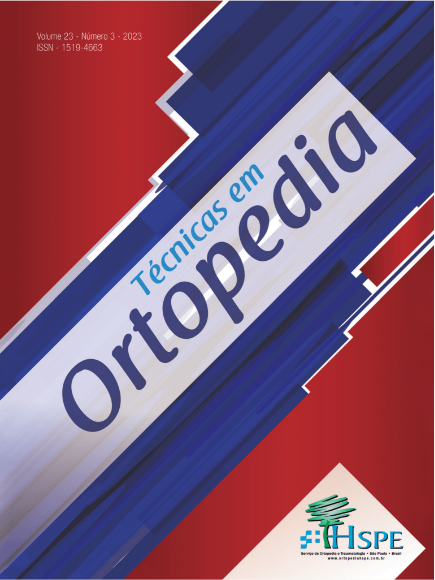Correção de geno valgo em criança com crescimento guiado
DOI:
https://doi.org/10.61443/rto.v23i1.417Palavras-chave:
geno valgo; correção gradual; hemiepifisiodese; placa em oito.Resumo
A hemiepifisiodese com implantes em banda de tensão tipo “placas em oito” trouxe grande versatilidade para as correções angulares em ortopedia infantil, devido a técnica minimamente invasiva, sem necessidade de imobilização, e correção gradual. Descrevemos a correção de uma deformidade importante em valgo, com obtenção do alinhamento adequado em 7 meses.
Downloads
Referências
Phemister DB. Operative arrestment of longitudinal growth of bone in the treatment of deformities. J Bone Joint Surg Am.1933;15(1):1-15.
Blount WP, Clarke GR. Control of bone growth by epiphyseal stapling; a preliminary report. J Bone Joint Surg Am. 1949;31(3): 464-78.
Blount WP. A mature look at epiphyseal stapling. Clin Orthop Relat Res. 1971;77:158-63.
Métaizeau JP, Wong-Chung J, Bertrand H, Pasquier P. Percutaneous epiphysiodesis using transphyseal screws (PETS). J Pediatr Orthop. 1998;18(3):363-9.
Stevens PM, Maguire M, Dales MD, Robins AJ. Physeal stapling for idiopathic genu valgum. J Pediatr Orthop. 1999;19(5):645-9.
Stevens PM. Guided growth for angular correction: a preliminary series using a tension band plate. J Pediatr Orthop.
;27(3):253-9.
Stevens PM. Guided growth: 1933 to the present. Strategies Trauma Limb Reconstr. 2006;1(1):29-35.
Stevens PM, Klatt JB. Guided growth for pathological physes: radiographic improvement during realignment. J Pediatr Orthop. 2008;28(6):632-9.
Burghardt RD, Herzenberg JE, Standard SC, Paley D. Temporary hemiepiphyseal arrest using a screw and plate device to treat knee and ankle deformities in children: a preliminary report. J Child Orthop. 2008;2(3):187-97.
Burghardt RD, Herzenberg JE. Temporary hemiepiphysiodesis with the eight-Plate for angular deformities: mid-term results. J Orthop Sci. 2010;15(5):699-704.
Marangoz S, Buyukdogan K, Karahan S. Is there a correlation between the change in the interscrew angle of the eight-plate
and the delta joint orientation angles? Acta Orthop Traumatol Turc. 2017;51(1):39-43.
Paley D, Tetsworth K. Mechanical axis deviation of the lower limbs. Preoperative planning of uniapical angular deformities of
the tibia or femur. Clin Orthop Relat Res. 1992;280:48-64.
Sharma L, Song J, Dunlop D, Felson D, Lewis CE, Segal N, et al. Varus and valgus alignment and incident and progressive knee osteoarthritis. Ann Rheum Dis. 2010;69(11):1940-5.
Boero S, Michelis MB, Riganti S. Use of the eight-Plate for angular correction of knee deformities due to idiopathic and
pathologic physis: initiating treatment according to etiology. J Child Orthop. 2011;5(3):209-16.
van Oosterbos M, van der Zwan AL, van der Woude HJ, Ham SJ. Correction of ankle valgus by hemiepiphysiodesis using
the tension band principle in patients with multiple hereditary exostosis. J Child Orthop. 2016 Jun;10(3):267-73.
Kemppainen JW, Hood KA, Roocroft JH, Schlechter JA, Edmonds EW. Incomplete Follow-up After Growth Modulation Surgery: Incidence and Associated Complications. J Pediatr Orthop. 2016;36(5):516-20





